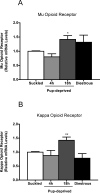Mu and kappa opioid receptor expression in the mediobasal hypothalamus and effectiveness of selective antagonists on prolactin release during lactation
- PMID: 20045447
- PMCID: PMC2824054
- DOI: 10.1016/j.neuroscience.2009.12.066
Mu and kappa opioid receptor expression in the mediobasal hypothalamus and effectiveness of selective antagonists on prolactin release during lactation
Abstract
Endogenous opioid peptides are involved in prolactin release during lactation, in part by decreasing tuberoinfundibular dopaminergic (TIDA) neuronal activity. Both mu (mu) and kappa (kappa) opioid receptors have a role in the suckling-induced prolactin rise after 4-5 h up deprivation. The aim of this study was to investigate effects of mu opioid receptor antagonist, beta-funaltrexamine (beta-FNA), and kappa opioid receptor antagonist, nor-binaltorphimine (nor-BNI), on prolactin secretion and TIDA neuronal activity in lactating rats after 18 h pup deprivation. After 4 h separation from pups, the suckling-induced prolactin rise was abolished by 16 microg nor-BNI and 5 microg beta-FNA, coincident with increased dihydroxyphenylacetic acid (DOPAC):dopamine ratio in the stalk-median eminence (SME). However, after 18 h pups separation, these same doses of nor-BNI and beta-FNA did not alter the prolactin surge or DOPAC:dopamine ratios in the SME. Higher doses of nor-BNI (32 microg) and beta-FNA (10 microg) were required to inhibit suckling-induced prolactin secretion. beta-FNA (10 microg) increased the DOPAC:dopamine ratio in the SME, whereas nor-BNI (32 microg) treatment had no effect. The mu and kappa opioid receptor mRNA levels in the mediobasal hypothalamus were similar to suckled control rats after 4 h pup deprivation, but increased 1.4-fold after 18 h pup deprivation. These data support involvement of endogenous opioidergic systems in the suckling-induced prolactin rise after a prolonged (18 h) period of pup deprivation, as well as the shorter (4 h) pup deprivation period previously reported. Suppression of TIDA neuronal activity likely played a part in mu opioid receptor input to the suckling-induced prolactin rise after both 4 h and 18 h separation, whereas non-dopaminergic input was implicated with kappa opioid receptors after 18 h pup deprivation. Increased mu and kappa opioid receptors gene expression in the mediobasal hypothalamus may contribute to reduced effectiveness of opioid receptor antagonists to block suckling-induced prolactin release after 18 h pup deprivation.
Copyright (c) 2010 IBRO. Published by Elsevier Ltd. All rights reserved.
Figures



Similar articles
-
Inhibition of tuberoinfundibular dopaminergic neural activity during suckling: involvement of mu and kappa opiate receptor subtypes.J Neuroendocrinol. 1996 Oct;8(10):771-6. doi: 10.1046/j.1365-2826.1996.05207.x. J Neuroendocrinol. 1996. PMID: 8910807
-
Opioid receptor subtypes involved in the regulation of prolactin secretion during pregnancy and lactation.J Neuroendocrinol. 2003 Mar;15(3):227-36. doi: 10.1046/j.1365-2826.2003.00975.x. J Neuroendocrinol. 2003. PMID: 12588510
-
Inhibition of suckling-induced prolactin release by mu- and kappa-opioid antagonists.Brain Res. 1991 Dec 20;567(2):224-30. doi: 10.1016/0006-8993(91)90799-2. Brain Res. 1991. PMID: 1667901
-
Endogenous opioid peptides contribute to suckling-induced prolactin release by suppressing tyrosine hydroxylase activity and messenger ribonucleic acid levels in tuberoinfundibular dopaminergic neurons.Endocrinology. 1998 Jun;139(6):2857-62. doi: 10.1210/endo.139.6.6052. Endocrinology. 1998. PMID: 9607794
-
A bold view of the lactating brain: functional magnetic resonance imaging studies of suckling in awake dams.J Neuroendocrinol. 2011 Nov;23(11):1009-19. doi: 10.1111/j.1365-2826.2011.02184.x. J Neuroendocrinol. 2011. PMID: 21722215 Free PMC article. Review.
Cited by
-
Completely humanizing prolactin rescues infertility in prolactin knockout mice and leads to human prolactin expression in extrapituitary mouse tissues.Endocrinology. 2013 Dec;154(12):4777-89. doi: 10.1210/en.2013-1476. Epub 2013 Sep 12. Endocrinology. 2013. PMID: 24029242 Free PMC article.
-
Opioid Receptor-Mediated Regulation of Neurotransmission in the Brain.Front Mol Neurosci. 2022 Jun 15;15:919773. doi: 10.3389/fnmol.2022.919773. eCollection 2022. Front Mol Neurosci. 2022. PMID: 35782382 Free PMC article. Review.
-
Opioid-mediated regulation of A11 diencephalospinal dopamine neurons: pharmacological evidence of activation by morphine.Neuropharmacology. 2011 Sep;61(4):614-21. doi: 10.1016/j.neuropharm.2011.05.002. Epub 2011 May 13. Neuropharmacology. 2011. PMID: 21605572 Free PMC article.
-
Promoting effects of isobavachin on neurogenesis of mouse embryonic stem cells were associated with protein prenylation.Acta Pharmacol Sin. 2011 Apr;32(4):425-32. doi: 10.1038/aps.2011.5. Epub 2011 Mar 28. Acta Pharmacol Sin. 2011. PMID: 21441946 Free PMC article.
References
-
- Andrews ZB, Grattan DR. Opioid receptor subtypes involved in the regulation of prolactin secretion during pregnancy and lactation. J Neuroendocrinol. 2003;15:227–236. - PubMed
-
- Anton B, Fein J, To T, Li X, Silberstein L, Evans CJ. Immunohistochemical localization of ORL-1 in the central nervous system of the rat. J Comp Neurol. 1996;368:229–251. - PubMed
-
- Arbogast LA, Voogt JL. Hyperprolactinemia increases and hypoprolactinemia decreases tyrosine hydroxylase messenger ribonucleic acid levels in the arcuate nuclei, but not the substantia nigra or zona incerta. Endocrinology. 1991;128:997–1005. - PubMed
-
- Arbogast LA, Voogt JL. Endogenous opioid peptides contribute to suckling-induced prolactin release by suppressing tyrosine hydroxylase activity and messenger ribonucleic acid levels in tuberoinfundibular dopaminergic neurons. Endocrinology. 1998;139:2857–2862. - PubMed
-
- Arita J, Porter JC. Relationship between dopamine release into hypophysial portal blood and prolactin release after morphine treatment in rats. Neuroendocrinology. 1984;38:62–67. - PubMed
Publication types
MeSH terms
Substances
Grants and funding
LinkOut - more resources
Full Text Sources
Research Materials

